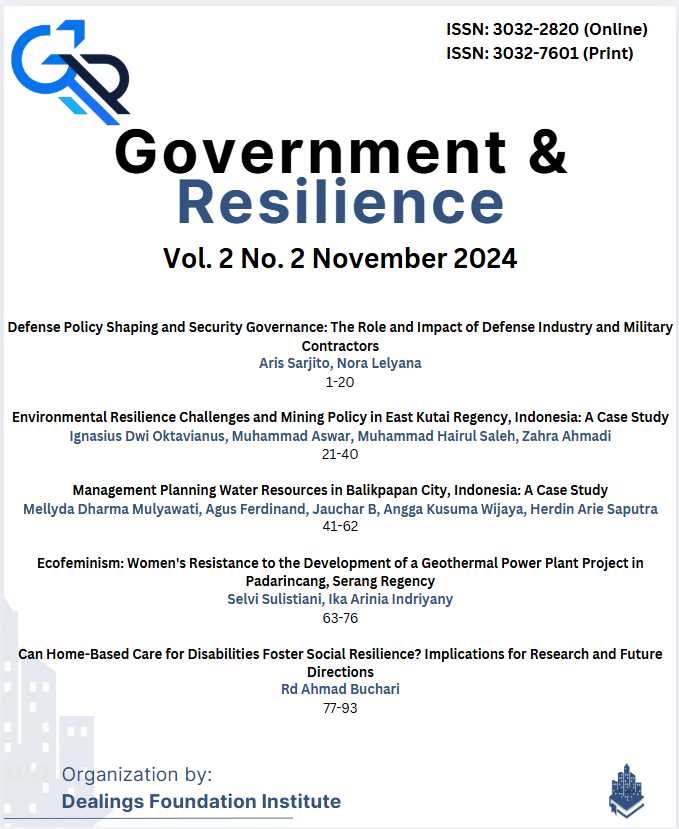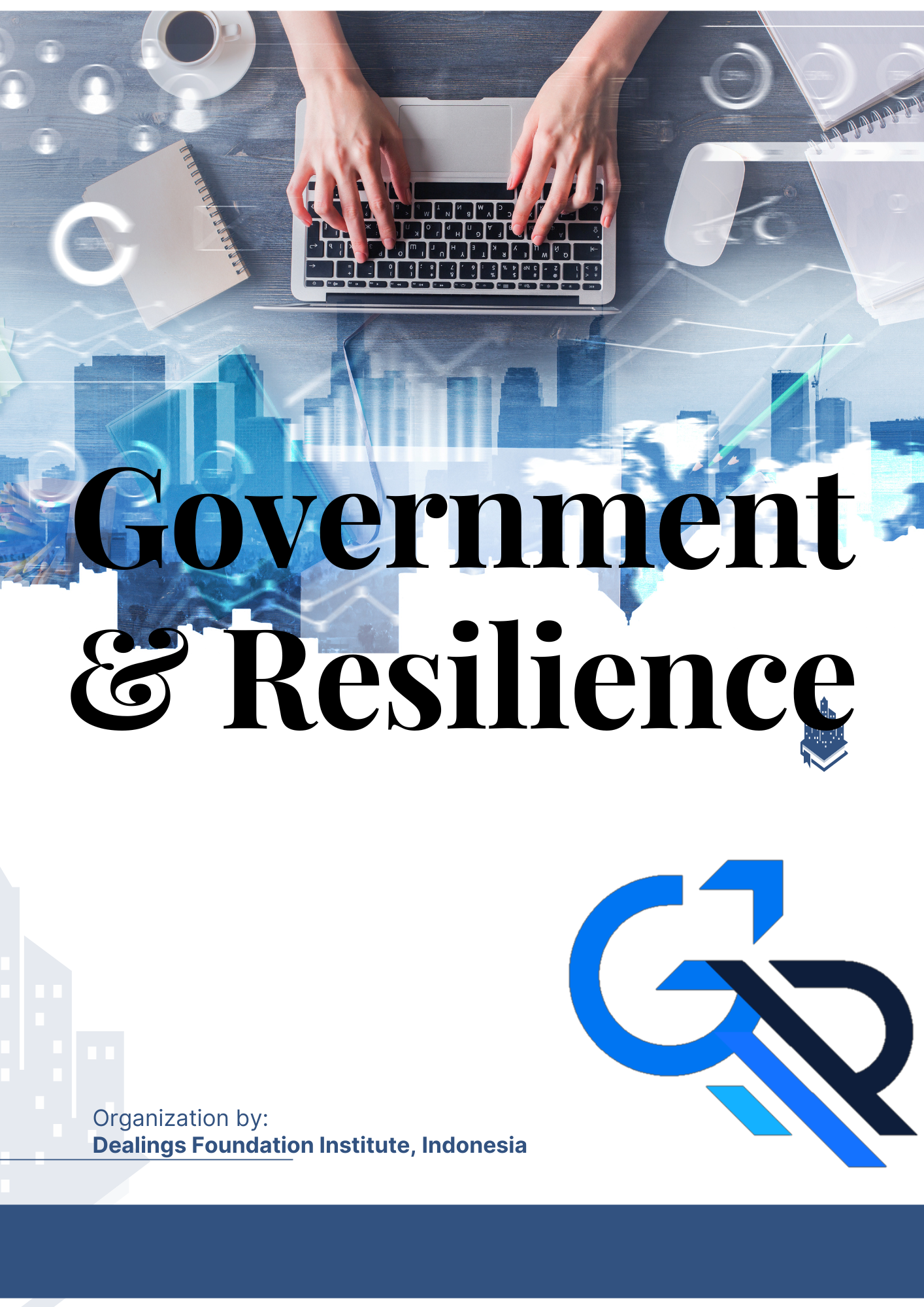Environmental Resilience Challenges and Mining Policy in East Kutai Regency, Indonesia: A Case Study
DOI:
https://doi.org/10.62503/gr.v2i2.16Keywords:
Local government, Civil Service Police, Mining C, Environmental Challenges, East Kutai RegencyAbstract
This study aims to identify weaknesses in the oversight of excavation C mining activities by the East Kutai Regency Government, which contribute to soil degradation and alterations to natural landscapes. These mining operations result in large, water-filled pits that become breeding grounds for mosquitoes and disease, while also causing air pollution during the dry season. The research employs a qualitative approach, combining a literature review with interviews. The findings reveal that, first, excavation C mining disrupts ecosystem balance through the overexploitation of natural resources and fosters illegal mining activities. Second, challenges in monitoring excavation C mining involve the Satpol PP (Civil Service Police Unit) as the primary enforcement body, along with the enforcement of local regulations designed to minimize environmental damage. However, a lack of coordination between the East Kutai Regency Satpol PP and the East Kalimantan Provincial Police complicates regulatory enforcement and community protection efforts. This study recommends implementing strict sanctions against companies that illegally damage the environment to improve oversight effectiveness and promote environmental sustainability.
References
Afrizal, A., Heriyanto, M., & Yuliani, F. (2023). Supervision of the Pamong Praja Police Unit on street vendors in Bangko District, Rokan Hilir Regency. Pro Patria: Journal of Education, Citizenship, Law, Social, and Politics, 6(1), 157–172. https://doi.org/10.47080/propatria.v6i1.1663
Aprilianadi, F., & Noor, M. (2024). Coastal Tourism Development Strategy In Pasir Mayang Village, Paser Regency. 2024(4), 417–427.
Ashraf, U., Shi, W., Zhang, H., Anees, A., Jiang, R., Ali, M., Mangi, H. N., & Zhang, X. (2024). Reservoir rock typing assessment in a coal-tight sand based heterogeneous geological formation through advanced AI methods. Scientific Reports, 14(1). https://doi.org/10.1038/s41598-024-55250-y
Asril. (2014). The Impact of Mining C on the Life of the People of Koto Kampar Hulu District, Kampar Regency. Journal of Entrepreneurship, Vol. 13(1), 18.
Aulia, S., Albar, A., & Kahfi, A. (2024). Management of Excavation C Mine on the Environment in Bulukumba Regency; Analysis of Fiqh Bi 'ah Management of Mine C Excavation on the Environment in Bulukumba Regency ; Analysis of Bi 'ah Fiqh Introduction to Indonesia which adheres to constitutional principles. 05(1), 72–88. https://doi.org/10.24252/shautuna.v5i1.40066
Azadi, M., Edraki, M., Farhang, F., & Ahn, J. (2019). Opportunities for mineral carbonation in Australia's mining industry. In Sustainability (Switzerland) (Vol. 11, Issue 5). MDPI. https://doi.org/10.3390/su11051250
Bai, J., Xu, X., Duan, Y., Zhang, G., Wang, Z., Wang, L., & Zheng, C. (2022). Evaluation of resource and environmental carrying capacity in rare earth mining areas in China. Scientific Reports, 12(1). https://doi.org/10.1038/s41598-022-10105-2
Bebbington, A. J., Bury, J., Cuba, N., & Rogan, J. (2015). Mining, risk and climate resilience in the "other" Pacific: Latin American lessons for the South Pacific. Asia Pacific Viewpoint, 56(2), 189–207. https://doi.org/10.1111/apv.12098
Bridge, G. (2004). Contested terrain: Mining and the environment. In Annual Review of Environment and Resources (Vol. 29, pp. 205–259). https://doi.org/10.1146/annurev.energy.28.011503.163434
Brottrager, M., Crespo Cuaresma, J., Kniveton, D., & Ali, S. H. (2023). Natural resources modulate the nexus between environmental shocks and human mobility. Nature Communications, 14(1). https://doi.org/10.1038/s41467-023-37074-y
Cisneros, P. (2021). Policy designs for interorganizational coordination: Lessons from failures in governing the mining sector in Colombia and Ecuador. Latin American Policy, 12(1), 6–34. https://doi.org/10.1111/lamp.12211
Deller, S. C., & Schreiber, A. (2012). The Review of Regional Studies Mining and Community Economic Growth *. The Official Journal of the Southern Regional Science Association, 42, 121–141. www.srsa.org/rrs
Dino, G. A., Mancini, S., Lasagna, M., Bonetto, S. M. R., De Luca, D. A., Pereira, M. D., Baptista, E. H., de Ferro Miranda Miguel, I. L., Nuvunga, F., Victória, S. S., & Rodrigues, N. (2022). Cooperative Projects to Share Good Practices towards More Effective Sustainable Mining—SUGERE: A Case Study. Sustainability (Switzerland), 14(6). https://doi.org/10.3390/su14063162
Emetumah, F. C., Okoye, P. A. C., & Okoye, C. O. (2020). Sustainable Approach in the Assessment of Safety and Environmental Regulatory Compliance During Mining Activities. Journal of Human Ecology, 2020(3), 104–115. https://doi.org/10.31901/24566608.2020/72.1-3.3278ï
Farasi, A. (2010). Qualitative research methodology in the social field. Alphabeta.
Feng, D., Zhenhua, L., Songtao, L., Xiaolei, L., Guodong, L., Xuan, F., Hao, R., & Zhengzheng, C. (2024). Breaking law of overburden rock and key mining technology for narrow coal pillar working face in isolated island. Scientific Reports, 14(1), 13045. https://doi.org/10.1038/s41598-024-63814-1
Fikru, M. G. (2024). An economic framework for assessing the impact of domestic mining policies on affordable energy transition. Scientific Reports, 14(1), 13615. https://doi.org/10.1038/s41598-024-64535-1
Ghose, M. K., & Majee, S. R. (2001). Air pollution caused by opencast mining and its abatement measures in India. Journal of Environmental Management, 63(2), 193–202. https://doi.org/10.1006/jema.2001.0434
Githiria, J. M., & Onifade, M. (2020a). The impact of mining on sustainable practices and the traditional culture of developing countries. In Journal of Environmental Studies and Sciences (Vol. 10, Issue 4, pp. 394–410). Springer. https://doi.org/10.1007/s13412-020-00613-w
Githiria, J. M., & Onifade, M. (2020b). The impact of mining on sustainable practices and the traditional culture of developing countries. In Journal of Environmental Studies and Sciences (Vol. 10, Issue 4, pp. 394–410). Springer. https://doi.org/10.1007/s13412-020-00613-w
Hulukati, M., & Isa, Abd. H. (2020a). The Impact of Sand Mining on Environmental Sustainability in Tumbihe Village. Jambura Journal of Community Empowerment, 1(2), 44–53. https://doi.org/10.37411/jjce.v1i2.464
Hulukati, M., & Isa, Abd. H. (2020b). The Impact of Sand Mining on Environmental Sustainability in Tumbihe Village. Jambura Journal of Community Empowerment, 1(2), 44–53. https://doi.org/10.37411/jjce.v1i2.464
Idris, A. S., Syaifuddin, T. I., Effendi, S. N., Alaydrus, A., Idris, A., & B, J. (2023). Corporate Social Responsibility and Sustainable Development Goals: How the Mining Industry Supports Quality Education in Paser Regency (Issue Icsp). Atlantis Press SARL. https://doi.org/10.2991/978-2-38476-194-4_4
Iftitah, N. (2023). Environmental and Economic Impact Analysis on Excavation C Mining in Tiromanda Village. repository.iainpalopo.ac.id.
Jalalian, M. H., Bagherpour, R., & Khoshouei, M. (2023). Environmentally sustainable mining in quarries to reduce waste production and loss of resources using the developed optimization algorithm. Scientific Reports, 13(1). https://doi.org/10.1038/s41598-023-49633-w
John W. Creswell. (2018). Research Design Qualitative, Quantitative, and Mixed Methods Approaches Fifth Edition.
Lebel, L., Anderies, J. M., Campbell, B., Folke, C., Hatfield-Dodds, S., Hughes, T. P., & Wilson, J. (2006). Governance and the Capacity to Manage Resilience in Regional Social-Ecological Systems (Vol. 11, Issue 1). and Society. https://about.jstor.org/terms
Liyandi, M. J., Indriyany, I. A., & Prastio, L. O. (2024). "School Mother Program": Women Resilience Program or Gender Blind Policy? Government & Resilience, 2(1), 46–57. https://doi.org/10.62503/gr.v2i1.13
Maher, R., Valenzuela, F., & Böhm, S. (2019). The Enduring State: An analysis of governance-making in three mining conflicts. Organization Studies, 40(8), 1169–1191. https://doi.org/10.1177/0170840619847724
Matovu, B., Brouwer, F., Bleischwitz, R., Aljanabi, F., & Alkoyak-Yildiz, M. (2024). Resource nexus perspectives in the Blue Economy of India: The case of sand mining in Kerala. Environmental Science and Policy, 151. https://doi.org/10.1016/j.envsci.2023.103617
Mulenga, C. (2022). Soil governance and the control of mining pollution in Zambia. Soil Security, 6. https://doi.org/10.1016/j.soisec.2022.100039
Nelson, D. R., Adger, W. N., & Brown, K. (2007). Adaptation to environmental change: contributions of a resilience framework. Annual Review of Environment and Resources, 32, 395–419. https://doi.org/10.1146/annurev.energy.32.051807.090348
Ngugi, H. N. (2023). Ecology Of Immature Stages Of The Dengue Fever Vector Aedes Aegypti (L.) (Diptera: Culicidae) In Rural And Urban Sites Of The Southern Coast Of Kenya Ngugi Harun Njenga (Doctoral dissertation, University of Nairobi).
Noviariza, I., & Wdy Wibowo, S. (2018). The efforts of the Samarinda City Civil Service Police Unit in tackling homeless people and beggars through persuasive communication in Samarinda City. EJournal Communication Sciences, 6(3), 648–662.
Nurmiyati, N., Rahmawati, Di. E., & Efendi, D. (2021). Natural Resource Politics: A Study on the Interests of Local Political Elites in Regional Expansion in Paser Regency, East Kalimantan Province. JWP (Journal of Political Discourse), 6(1), 49. https://doi.org/10.24198/jwp.v6i1.29810
Nwadialor, I. (2012). Minimizing the Impact of Mining Activities for Sustainable Mined-Out Area Conservation In Nigeria. FUTY Journal of the Environment, 6(2). https://doi.org/10.4314/fje.v6i2.6
Pavloudakis, F., Roumpos, C., Karlopoulos, E., & Koukouzas, N. (2020). Sustainable rehabilitation of surface coal mining areas: The case of greek lignite mines. Energies, 13(15). https://doi.org/10.3390/en13153995
Payeste, M., Kolahi, M., & Khorasani, H. O. (n.d.). Criteria and Indicators; Requirement for Cognition, Applying and Evaluating Good Governance in Natural Resources Conceptual. 7(1). https://doi.org/10.22067/jwsd.v7i1.81456
Pertiwi, N. (2009). Mapping of the mining location of group C mining materials in Semarang Regency using.
Pratama, M. R., & Surur, F. (2021). The Effect of Excavation C Mining Activities on Changes in the Physical Environment in Parangloe District, Gowa Regency. In Journal of Science, Technology & Environment (Vol. 7, Issue 1, pp. 13–23). scholar.archive.org. https://doi.org/10.29303/jstl.v7i1.200
Prno, J., & Slocombe, D. S. (2014). A systems-based conceptual framework for assessing the determinants of a social license to operate in the mining industry. Environmental Management, 53(3), 672–689. https://doi.org/10.1007/s00267-013-0221-7
Rahmadanita, A., & Nurrahman, A. (2022). Implementation of the function of maintaining peace and public order by the Civil Service Police Unit in Bogor City. Journal of Tatapamong, 113–127. https://doi.org/10.33701/jurnaltatapamong.v4i2.3014
Rahmah, S. A. (2019). The impact of quarry management c on the environment. In Researchgate.Net (Issue July).
Rosita, R., Ibrahim, K., & Gunawan, G. (2022). The Impact of Excavation C on the Natural Environment of the Mining Circle Community in Ternate City. Cannarium, 20(1). https://doi.org/10.33387/cannarium.v20i1.4860
Said, M. (2017). Mining Policy: Regulation for Whom? In Said / JIAP (Vol. 3, Issue 3).
Saleh, M. H., Saleh, M. H., & Oktavianus, I. D. (2023). Intercultural Communication of Immigrant Communities on Sebatik Island, Indonesia-Malaysia Border. Communicative Journal, 12(2), 212–222. https://doi.org/10.33508/jk.v12i2.5068
Samuel Spiegel, B. B. (2017). Heed local impact of coal mining.
Sanjaya, A., Ketut Gunawan, I., Arhas, S. H., & Pratama, S. M. (2022). The Influence of Economic Conditions and Psychological Conditions of the Community on Government Readiness in the Development of the National Capital. http://creativecommons.org/licenses/by/4.0/
Schomberg, A. C., Bringezu, S., Flörke, M., & Biederbick, H. (2022). Spatially explicit life cycle assessments reveal hotspots of environmental impacts from renewable electricity generation. Communications Earth and Environment, 3(1). https://doi.org/10.1038/s43247-022-00521-7
Setiawan, B., & Hadi, S. P. (2007). Regional autonomy and local resource management in Indonesia. Asia Pacific Viewpoint, 48(1), 72-84. https://doi.org/10.1111/j.1467-8373.2007.00331.x
Smith, K., & Sepasgozar, S. (2022). Governance, Standards and Regulation: What Construction and Mining Need to Commit to Industry 4.0. In Buildings (Vol. 12, Issue 7). MDPI. https://doi.org/10.3390/buildings12071064
Sonter, L. J., Herrera, D., Barrett, D. J., Galford, G. L., Moran, C. J., & Soares-Filho, B. S. (2017). Mining drives extensive deforestation in the Brazilian Amazon. Nature Communications, 8(1). https://doi.org/10.1038/s41467-017-00557-w
Spiegel, S. J. (2012). Governance Institutions, Resource Rights Regimes, and the Informal Mining Sector: Regulatory Complexities in Indonesia. World Development, 40(1), 189–205. https://doi.org/10.1016/j.worlddev.2011.05.015
Suhartono, S. (2013). Decentralization of natural resource management to realize community welfare. DiH: Journal of Legal Sciences, 9(18). https://doi.org/10.30996/dih.v9i18.278
Sukandarrumidi. (2018). Geology of Metal Minerals for Young Explorers. Gadjah Mada University Press.
Sun, Y., Jiang, S., & Wang, S. (2024a). The environmental impacts and sustainable pathways of the global diamond industry. Humanities and Social Sciences Communications, 11(1). https://doi.org/10.1057/s41599-024-03195-y
Syaodih, N. (2009). Educational Research Methods. King Grafindo Persada.
Weichselgartner, J., & Kelman, I. (2015). Geographies of resilience: Challenges and opportunities of a descriptive concept. Progress in Human Geography, 39(3), 249–267. https://doi.org/10.1177/0309132513518834
Wilms, F., Berendt, F., Bronisz, K., Bashutska, U., Fotelli, M., Radoglou, K., & Spyroglou, G. (2024). Applying taper function models for black locust plantations in Greek post-mining areas. Scientific Reports, 14(1), 13557. https://doi.org/10.1038/s41598-024-63048-1
Wilson, G. A. (2013). Community resilience, policy corridors and the policy challenge. Land Use Policy, 31, 298–310. https://doi.org/10.1016/j.landusepol.2012.07.011
Xu, Y., Li, J., Zhang, C., Raval, S., Guo, L., & Yang, F. (2024). Dynamics of carbon sequestration in vegetation affected by large-scale surface coal mining and subsequent restoration. Scientific Reports, 14(1), 13479. https://doi.org/10.1038/s41598-024-64381-1
Yakovleva, N., & Vazquez-Brust, D. (2012). Stakeholder Perspectives on CSR of Mining MNCs in Argentina. Journal of Business Ethics, 106(2), 191–211. https://doi.org/10.1007/s10551-011-0989-4
Zachrisson, A., & Beland Lindahl, K. (2019). Political opportunity and mobilization: The evolution of a Swedish mining-sceptical movement. Resources Policy, 64. https://doi.org/10.1016/j.resourpol.2019.101477
Zhu, C., Chen, Y., Wan, Z., Chen, Z., Lin, J., Chen, P., Sun, W., Yuan, H., & Zhang, Y. (2023). Cross-sensitivity analysis of land use transition and ecological service values in rare earth mining areas in southern China. Scientific Reports, 13(1). https://doi.org/10.1038/s41598-023-49015-2
Downloads
Published
How to Cite
Issue
Section
License
Copyright (c) 2024 Government & Resilience

This work is licensed under a Creative Commons Attribution-NonCommercial-ShareAlike 4.0 International License.
1. Licence
Use of articles will be governed by the Creative Commons Attribution-NonCommercial-ShareAlike 4.0 International license as currently displayed on the Creative Commons Attribution-NonCommercial-ShareAlike 4.0 International License (CC BY-NC-SA 4.0).
2. Author(s)' Warranties
The author warrants that the article is original, written by the stated author(s), has not been published before, contains no unlawful statements, does not infringe the rights of others, is subject to copyright that is vested exclusively in the author and free of any third-party rights, and that any necessary written permissions to quote from other sources have been obtained by the author(s).
3. User Rights
The spirit of Government & Resilience is to disseminate articles published as freely as possible. Under the Creative Commons license, Government & Resilience permits users to copy, distribute, display, and perform the work. Users will also need to attribute authors and Government & Resilience for distributing works in journals and other media of publication.
4. Rights of Authors
Authors retain all their rights to the published works, such as (but not limited to) the following rights:
1. Copyright and other proprietary rights relating to the article, such as patent rights,
2. The right to use the substance of the article in future works, including lectures and books,
3. The right to reproduce the article for own purposes,
4. The right to enter into separate, additional contractual arrangements for the non-exclusive distribution of the article's published version (e.g., post it to an institutional repository or publish it in a book), with an acknowledgment of its initial publication in this journal (Government & Resilience).
5. Co-Authorship
If the article was jointly prepared by more than one author, any author submitting the manuscript warrants that he or she has been authorized by all co-authors to agree on this copyright and license notice (agreement) on their behalf and agrees to inform his or her co-authors of the terms of this policy. Government & Resilience will not be held liable for anything that may arise due to the author's internal dispute. Government & Resilience will only communicate with the corresponding author.
6. Royalties
Being an open-access journal and disseminating articles for free under the Creative Commons license term mentioned, the author(s) are aware that Government & Resilience entitles the author(s) to no royalties or other fees.











